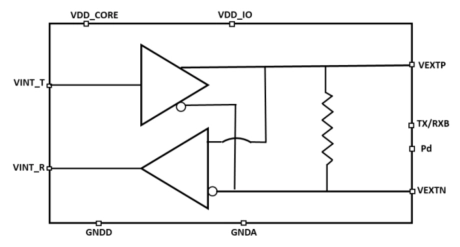LVDS IP
Filter
Compare
319
IP
from
63
vendors
(1
-
10)
-
1 Gb/s LVDS Bidirectional IO on 12nm
- The ODT-LVDS-BID1G-12nm is a high-speed Bidirectional LVDS IO cell capable of operating up to 1 Gb/s.
- The ODT-LVDS-BID1G-12nm uses a high-speed signal path that can provide low jitter for input ranges of up to 1 Gb/s input.
- It also features small area and low power consumption.
- It includes the internal termination resistor and ESD protection diodes on the VEXTP and VEXTN pins.

-
TSMC N4P LVDS IO 1.5V MS add-on
- Synopsys Low Voltage Differential Signaling (LVDS) IO library is a high-frequency interface that uses differential signals for data transmission
- A few typical LVDS IO applications are in display monitors, printers, high-speed clock transfers, and high-speed SERDES
- Synopsys LVDS IO library is used to build an LVDS-based interface for high-speed interconnect applications
- This library is designed to optimize IO performance with a core voltage of 0.75 V and supports an IO supply voltage of 1.2V/1.5 V
-
TSMC N4P LVDS IO 1.5V
- Synopsys Low Voltage Differential Signaling (LVDS) IO library is a high-frequency interface that uses differential signals for data transmission
- A few typical LVDS IO applications are in display monitors, printers, high-speed clock transfers, and high-speed SERDES
- Synopsys LVDS IO library is used to build an LVDS-based interface for high-speed interconnect applications
- This library is designed to optimize IO performance with a core voltage of 0.75 V and supports an IO supply voltage of 1.2V/1.5 V
-
TSMC N4P LVDS IO 1.2V MS add-on
- Synopsys Low Voltage Differential Signaling (LVDS) IO library is a high-frequency interface that uses differential signals for data transmission
- A few typical LVDS IO applications are in display monitors, printers, high-speed clock transfers, and high-speed SERDES
- Synopsys LVDS IO library is used to build an LVDS-based interface for high-speed interconnect applications
- This library is designed to optimize IO performance with a core voltage of 0.75 V and supports an IO supply voltage of 1.2V/1.5 V
-
TSMC N4P LVDS IO 1.2V
- Synopsys Low Voltage Differential Signaling (LVDS) IO library is a high-frequency interface that uses differential signals for data transmission
- A few typical LVDS IO applications are in display monitors, printers, high-speed clock transfers, and high-speed SERDES
- Synopsys LVDS IO library is used to build an LVDS-based interface for high-speed interconnect applications
- This library is designed to optimize IO performance with a core voltage of 0.75 V and supports an IO supply voltage of 1.2V/1.5 V
-
TSMC N7 1.8V LVDS IO with CDM 7A, AG2 Platform
- Synopsys Low Voltage Differential Signaling (LVDS) IO library is a high-frequency interface that uses differential signals for data transmission
- A few typical LVDS IO applications are in display monitors, printers, high-speed clock transfers, and high-speed SERDES
- Synopsys LVDS IO library is used to build an LVDS-based interface for high-speed interconnect applications
- This library is designed to optimize IO performance with a core voltage of 0.75 V and supports an IO supply voltage of 1.2V/1.5 V
-
TSMC N6 1.8V LVDS IO with CDM 7A
- Synopsys Low Voltage Differential Signaling (LVDS) IO library is a high-frequency interface that uses differential signals for data transmission
- A few typical LVDS IO applications are in display monitors, printers, high-speed clock transfers, and high-speed SERDES
- Synopsys LVDS IO library is used to build an LVDS-based interface for high-speed interconnect applications
- This library is designed to optimize IO performance with a core voltage of 0.75 V and supports an IO supply voltage of 1.2V/1.5 V
-
TSMC N5A LVDS IO 1.2V/1.5V Metal Add-on
- Synopsys Low Voltage Differential Signaling (LVDS) IO library is a high-frequency interface that uses differential signals for data transmission
- A few typical LVDS IO applications are in display monitors, printers, high-speed clock transfers, and high-speed SERDES
- Synopsys LVDS IO library is used to build an LVDS-based interface for high-speed interconnect applications
- This library is designed to optimize IO performance with a core voltage of 0.75 V and supports an IO supply voltage of 1.2V/1.5 V
-
TSMC N5A LVDS IO 1.2V/1.5V
- Synopsys Low Voltage Differential Signaling (LVDS) IO library is a high-frequency interface that uses differential signals for data transmission
- A few typical LVDS IO applications are in display monitors, printers, high-speed clock transfers, and high-speed SERDES
- Synopsys LVDS IO library is used to build an LVDS-based interface for high-speed interconnect applications
- This library is designed to optimize IO performance with a core voltage of 0.75 V and supports an IO supply voltage of 1.2V/1.5 V
-
TSMC 5nm LVDS RX IO 1.5V
- Synopsys Low Voltage Differential Signaling (LVDS) IO library is a high-frequency interface that uses differential signals for data transmission
- A few typical LVDS IO applications are in display monitors, printers, high-speed clock transfers, and high-speed SERDES
- Synopsys LVDS IO library is used to build an LVDS-based interface for high-speed interconnect applications
- This library is designed to optimize IO performance with a core voltage of 0.75 V and supports an IO supply voltage of 1.2V/1.5 V